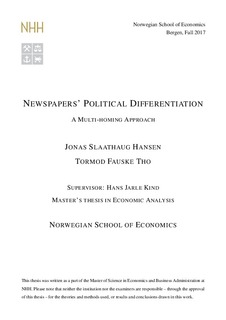| dc.description.abstract | In this paper, we propose a theoretical model of a two-sided media market which examines
the dynamic between newspapers, consumers and advertisers. We also review the
existing literature on bias in media divided into sections on supply-driven media bias,
demand-driven media bias, and empirical evidence of the existence of media bias. In
our model, we relax the assumption that consumers buy only one out of multiple products,
in line with recent contributions to the field. We also assume that consumers value
both reading news closer aligned with their own political opinions, as well as reading
news of high quality. They put relative weights on the two according to the verifiability
of each piece of news. We find that allowing consumers to buy both newspapers drives
the newspapers political differentiation to a minimum as they gather in the center of the
political spectrum. The model is the first of its kind since it combines multi-homing,
endogenous newspaper locations, the presence of advertisers, and a verifiability dimension.
Thus, this paper covers a topic not yet examined in the literature on media bias,
multi-homing, and two-sided markets. | nb_NO |
